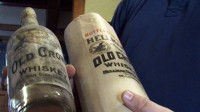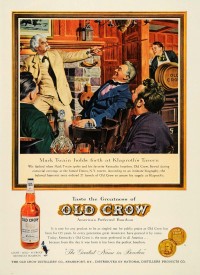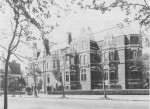 When Bryan and Emily Fite bought an 1850s home in St. Joseph, Missouri last year, they knew it needed work. One of the first projects they undertook was installing central heat and air, which they had to rewire the house to accomplish. Bryan pried up some floorboards in the attic to lay the new wires and underneath found mysterious tubes wrapped in paper with writing on it. His first thought was they were old steam heat conduits from when the house was first built that were wrapped in paper insulation. When he unwrapped the paper, instead of century-old pipe he found a century-old bottle of whiskey. Then he found 12 more of them.
When Bryan and Emily Fite bought an 1850s home in St. Joseph, Missouri last year, they knew it needed work. One of the first projects they undertook was installing central heat and air, which they had to rewire the house to accomplish. Bryan pried up some floorboards in the attic to lay the new wires and underneath found mysterious tubes wrapped in paper with writing on it. His first thought was they were old steam heat conduits from when the house was first built that were wrapped in paper insulation. When he unwrapped the paper, instead of century-old pipe he found a century-old bottle of whiskey. Then he found 12 more of them.
There are three different brands — Hellman’s Celebrated Old Crow whiskey, Guckenheimer Pennsylvania rye whiskey, W.H. McBrayer’s Cedar Brook whiskey — all of them bottled in 1917 and distilled four or five years earlier. On January 16, 1919, the eighteenth amendment to the US Constitution was ratified and Prohibition became the law of the land, decimating the whiskey distilling business. None of the makers of the Fites’ whiskeys survived.
The 1917 Hellman’s Old Crow might have been some of the last bottles ever sold. Hellman’s was sued for trademark infringement by W.A. Gaines and Company, a Kentucky liquor company which had produced a very famous brand of “Old Crow” whiskey since 1835. It was named for Doctor James C. Crow, a Scottish medical doctor who moved to Kentucky and in the 1830s used his knowledge of chemistry to invent the sour mash process for creating bourbon. The aged runs became known as “Old Crow” and were massively popular. After Dr. Crow’s death in 1856, W.A. Gaines and Co. continued to sell his original stock for as long as they could. When they ran out, they made a replica, although Crow’s exact formula was lost.
 “Old Crow” was the favorite brand of many notable 19th and 20th century figures like President Andrew Jackson, Kentucky Senator Henry Clay, Confederate general John Hunt Morgan, Walt Whitman, Mark Twain and Hunter S. Thompson. It had a huge reputation, a reputation W.A. Gaines and Company was keen not be sullied by the St. Louis blend the Hellman Distilling Company had been selling as “Celebrated Old Crow” since 1863 when the Civil War choked off liquor shipments from the South. Hellman’s countered that they owned the trademark to the name and the case dragged on in the courts for almost a decade until in 1918 the Supreme Court of these United States ruled decisively in Gaines’ favor.
“Old Crow” was the favorite brand of many notable 19th and 20th century figures like President Andrew Jackson, Kentucky Senator Henry Clay, Confederate general John Hunt Morgan, Walt Whitman, Mark Twain and Hunter S. Thompson. It had a huge reputation, a reputation W.A. Gaines and Company was keen not be sullied by the St. Louis blend the Hellman Distilling Company had been selling as “Celebrated Old Crow” since 1863 when the Civil War choked off liquor shipments from the South. Hellman’s countered that they owned the trademark to the name and the case dragged on in the courts for almost a decade until in 1918 the Supreme Court of these United States ruled decisively in Gaines’ favor.
Edson Bradley, a New York financier and the son of a prosperous Connecticut shoe manufacturer, invested in the Kentucky whiskey business in the 1880s. When W.A. Gaines and Co. incorporated in 1887, he was appointed vice president. It was he who registered the first company trademark to “Old Crow” in 1887, and all the subsequent trademark registrations done to try to muscle out the many, many copycats.
 Eventually he became president and was widely known in the press as the richest liquor baron in the country. By 1907 he was Scrooge McDuck rich and since this was the Gilded Age, he bought a city block on DuPont Circle in Washington, D.C. and built a French Gothic mansion complete with entire rooms ripped out of actual Gothic mansions in France. It had a chapel that could seat 150 and a complete multi-story 500-seat theater. It was known as Aladdin’s Palace and was the largest, richest home in D.C.
Eventually he became president and was widely known in the press as the richest liquor baron in the country. By 1907 he was Scrooge McDuck rich and since this was the Gilded Age, he bought a city block on DuPont Circle in Washington, D.C. and built a French Gothic mansion complete with entire rooms ripped out of actual Gothic mansions in France. It had a chapel that could seat 150 and a complete multi-story 500-seat theater. It was known as Aladdin’s Palace and was the largest, richest home in D.C.
When Prohibition hit, the Gaines Company struggled along for a few more years until it was dissolved in 1922. Bradley was 70 years old by then, so in February of 1923 he decided to retire to Newport, Rhode Island, along with all the other Gilded Age barons. In the epitome of Gilded Age baron style, he brought his palace with him. Over the next two years, the DuPont Circle house was dismantled stone by stone and shipped to Newport.
 He bought a property along the Cliff Walk which already had an 1885 Elizabethan Revival mansion on it called Sea View. No problem. Architect Howard Greenley just integrated it into the new house. Sea View became Seaview Terrace, with the old mansion now acting as the east wing of the composite mansion. Greenley gave it an integrated look with turrets inspired by the Loire Valley chateau of Chambord. Two years and two million dollars later, Seaview Terrace was completed.
He bought a property along the Cliff Walk which already had an 1885 Elizabethan Revival mansion on it called Sea View. No problem. Architect Howard Greenley just integrated it into the new house. Sea View became Seaview Terrace, with the old mansion now acting as the east wing of the composite mansion. Greenley gave it an integrated look with turrets inspired by the Loire Valley chateau of Chambord. Two years and two million dollars later, Seaview Terrace was completed.
Edson Bradley died 10 years later. In 1930, Bradley deeded Seaview Terrace to his daughter Julie, but she lost it to the City of Newport during World War II when she couldn’t keep up with the taxes. After that it passed through various hands, was used by two different schools, and most famously, between 1966 and 1971 the exterior was used as the outdoor set for Collinwood Mansion in the vampire soap Dark Shadows.
The estate was purchased in 1974 by Martin and Millicent Carey who restored it, but a building like this is constantly in need of more restoration. It is now known as Carey Mansion. Martin and Millicent’s daughter Denise Ann Carey lives there now, and luckily she’s an architect.
After the Repeal of Prohibition on December 5th, 1933, the Gaines plant in Frankfort, Kentucky and the rights to the Old Crow label were bought by the American Medicinal Spirits Company, who in turn sold them to National Distillers Products Company in 1947. National was bought by Jim Beam in 1985 who still produce an Old Crow label, although not out of the Frankfort plant which they closed.
Bryan Fite thinks the 13 bottles might have been a stash hidden by the first owner of their home. According to a history of the house they received when they bought it, the first owner lost the house after he was put in a sanitarium for alcoholism. Perhaps he was planning a party for his return from rehab, a party he never got to have.
The Fites do not plan to sell the whiskey. They’re history buffs and they love that they’ve found liquid gold under the floorboards of their attic. They might break the label on a bottle or two in 2017 to celebrate the centennial of their purchase, but otherwise, the whiskey is staying in the house where it was first stashed almost a hundred years ago.